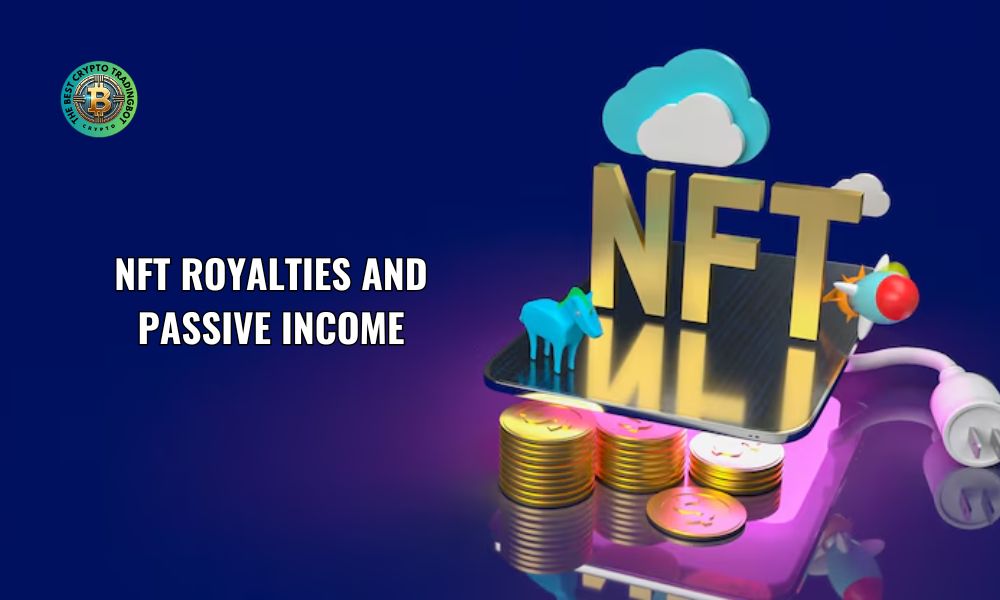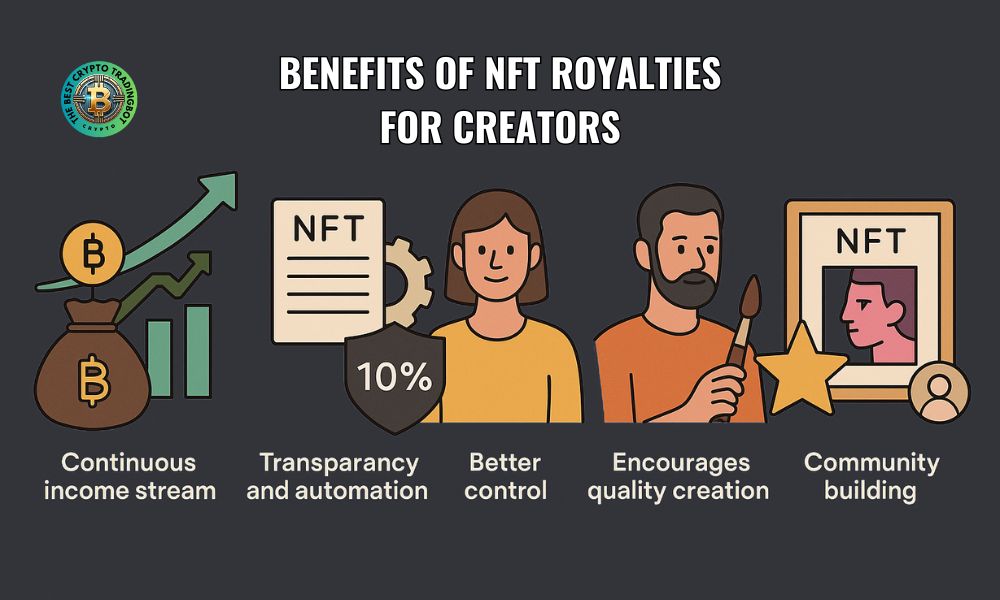NFT royalties and passive income offer a golden opportunity for creators as the NFT (Non-Fungible Token) market booms, bringing more than just unique digital artworks. This groundbreaking concept allows artists, musicians, and game developers to receive a percentage of revenue each time their NFT work is resold on the secondary market.

Contents
Traditional royalties and NFT royalties: what’s the difference?
In the traditional world, royalties are payments to intellectual property owners (e.g., authors, musicians) whenever their work is used or sold. However, tracking and collecting royalties is often complex, costly, and dependent on intermediaries.
NFT royalties offer a more elegant solution. Thanks to blockchain technology and smart contracts, setting up and enforcing royalties becomes automated and transparent. When an NFT is created (minted), the creator can code a royalty percentage directly into the NFT’s smart contract. This means that every time the NFT is resold on the secondary market, a portion of the sale price is automatically transferred to the original creator’s wallet. This is the core of generating NFT royalties and passive income.
How NFT royalties work
When an artist or creator releases an NFT collection, they define a royalty percentage (typically from 2.5% to 10%, sometimes higher) during the minting process. This percentage is written into the NFT’s metadata and enforced by the smart contract on the blockchain.
For example: an artist creates an NFT artwork and sets a 10% royalty.
- First sale (primary sale): the artist sells the NFT to buyer A for 1 ETH. The artist receives the full 1 ETH (minus gas fees and platform fees, if any).
- Second sale (secondary sale): buyer A resells that NFT to buyer B for 2 ETH. At this point, the smart contract will automatically deduct 10% of 2 ETH (which is 0.2 ETH) and transfer it to the artist. Buyer A receives 1.8 ETH (minus fees).
- This process continues for all subsequent resales, providing a continuous income stream for the artist.
This automation and transparency are outstanding strengths, helping creators easily track and receive well-deserved rewards for their efforts, facilitating the creation of a stable stream of NFT royalties and passive income.
Generating passive income with NFT royalties and passive income
The concept of “passive income” is when you earn money without needing to actively and continuously work for it. With NFT royalties and passive income, after creators complete their work and mint it as an NFT with the royalty mechanism set up, they can continue to receive income each time that NFT is traded on the secondary market.
This is a real game-changer, especially for digital artists, musicians, writers, or anyone creating content that can be tokenized. Instead of just getting paid once from the initial sale of their work, they have the opportunity to benefit from the increasing value and popularity of their work over time. This creates a strong incentive to produce high-quality works and build a community around their NFT project, because the long-term success of the project will directly translate into a sustainable flow of NFT royalties and passive income.
Benefits of NFT royalties for creators
Continuous income stream: This is the most obvious benefit. Instead of a one-time sale, creators receive a percentage each time their work is resold.
Transparency and automation: Smart contracts ensure royalty payments happen automatically, without third-party intervention, reducing risks and costs.
Better control: Creators have the power to decide the royalty percentage for their work.
Encourages quality creation: Knowing they can benefit long-term from their work gives creators more motivation to invest time and effort into creating valuable NFTs.
Community building: The royalty mechanism helps creators maintain a connection with their work and the community of NFT owners, as their interests are aligned with the project’s development. The biggest advantage that NFT royalties and passive income offer is this fairness and long-term earning potential.

Challenges and considerations
Although NFT royalties and passive income offer many opportunities, there are still challenges to be aware of:
Marketplace dependency: Not all NFT marketplaces fully support or enforce royalty mechanisms. Some platforms allow buyers to opt out of paying royalties, which can affect creators’ income. However, the general trend is that major platforms are increasingly respecting and enforcing royalties.
Gas fees: Transactions on the blockchain incur gas fees, and receiving royalties is no exception.
Market volatility: The value of NFTs and cryptocurrencies can be highly volatile, affecting the real value of the royalties received.
Marketing strategy needed: For NFTs to be traded frequently and generate royalties, creators need an effective promotion and community-building strategy.
Understanding these helps creators have a more realistic view when pursuing the path of NFT royalties and passive income.
The future of NFT royalties and passive income
Blockchain technology and NFTs are still in their early stages of development. However, the potential of NFT royalties and passive income is immense. In the future, we might see:
Better standardized royalty standards across blockchains and marketplaces.
More complex royalty models, such as sharing royalties among multiple contributors or with the community.
The application of NFT royalties expanding to many other fields beyond art and gaming, such as music, publishing, and software licensing.
In essence, NFT royalties and passive income unlock incredible potential for creators, offering sustainable earnings. While evolving, this mechanism is a game-changer. For the latest on NFTs, blockchain, and Web3, and to seize these opportunities, follow Blogmeme for continuous valuable insights and trend analysis.
